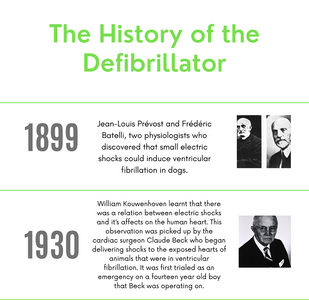Defibrillators - A Factual History Of This Incredible Device
A defibrillator is a medical device that is used to save the life of someone who is suffering from a cardiac arrest. They scan the heart to determine whether a shock is needed and if so will deliver one. If a defibrillator is used within the first minute of someone falling ill, chances of survival can be as high as 90%. But, when was it invented and has it changed much since the original design?
The first ever external defibrillator that is known today was invented in 1930 by electrical engineer William Kouwenhoven. Although, the first ever defibrillator was first demonstrated well over one hundred years ago in 1899 by Jean-Louis Prévost and Frédéric Batelli, two physiologists who discovered that small electric shocks could induce ventricular fibrillation in dogs.
Fast forward thirty years and William Kouwenhoven learnt that there was a relation between electric shocks and it’s affects on the human heart. This observation was picked up by the cardiac surgeon Claude Beck who began delivering shocks to the exposed hearts of animals that were in ventricular fibrillation. He would have likely carried on with these experiments however, when a fourteen year old boy’s heart stopped that he was operating on, he decided to trial his experiment in real life out of desperation.

The first shock failed however, the second shock saved the patients life and made national news. The defibrillator consisted of ‘a transformer to isolate the patient from the 110-volt ac wall supply, a variable resistor to limit the current to a heart-safe value, and two metal tablespoons with wooden handles to deliver the jolt to the exposed heart’.This was the start of the defibrillator as we now know it.
Meanwhile, in Europe and Russia, Beck and his colleagues’ counterparts were far ahead of them in terms of animal research when it came to defibrillators. There were a number of downsides to Becks’ research with patients often being left with nasty side affects including broken ribs and damage to the heart muscle, if they even survived at all. The scientists in Europe and Russia however, were using a single pulse or, fibrillation.
Over the following years, a number of scientists tried to develop a device that would incorporate affective fibrillation so that patients lives could be saved. Unfortunately, none could find the solution that worked. That was until 1950, when a major breakthrough occurred thanks to the introduction of the portable defibrillator.
The first ever portable defibrillator was the Czechoslovakia Gurvich Peleška's Prema defibrillator, developed in the Soviet Union and it was designed to be more portable than original models used elsewhere in the world. In the west however, the development of the portable defibrillator is accredited to Professor Frank Pantridge in Belfast in the early 1960’s developed the first truly portable device. It weighed over 70kg and even needed it’s own transport. Nothing like the defibrillators that we see in the 21st century.
Francis (Frank) Pantridge, is known as the ‘father’ or the modern AED. He was a physician and cardiologist from Norther Ireland and is responsible for transforming modern emergency medicine and paramedic services with the invention of the portable defibrillator.
Over the years, there has been gradual improvements in the design but the science largely remains the same. There is now wide availability of automated external defibrillators (AEDs) which now analyse the hearts rhythm, diagnose and charge and electric shock. It means that lay people can even use a defibrillator to save a life which takes out the time it take to wait for a professional to provide life saving care.
It’s safe to say that we can thank the creation of defibrillators on a number of pioneering scientists that dedicated their careers to developing a device that can save lives instantly. There are now thankfully a number of defibrillators available on the market which are appropriate for a number of environments should you work in an office, school or sports facility. Thanks to research, defibrillators are constantly being developed and improved to ensure they can be as effective as possible.
Recent Posts
-
What is CPR?
Knowing the basics of first aid and how to deliver CPR (cardiopulmonary resuscitation) can make the …17th Nov 2024 -
What is a sudden cardiac arrest (SCA)?
Sudden Cardiac Arrest (SCA) is a critical medical emergency where the heart abruptly ceases to funct …17th Nov 2024 -
Empowering Communities: The Lifesaving Impact of CPR on Restart a Heart Day
Every year, on and around October 16th, an important event takes place - Restart a Heart Day. This a …16th Oct 2023




